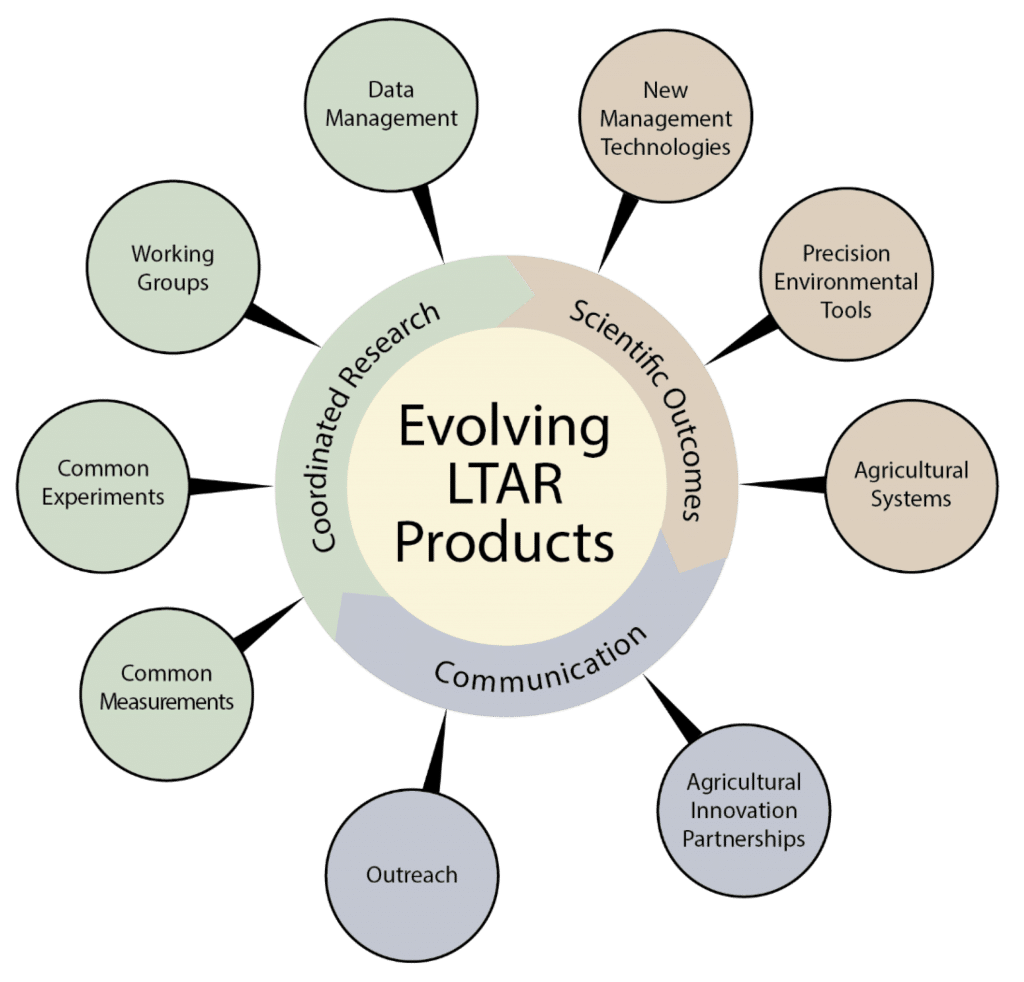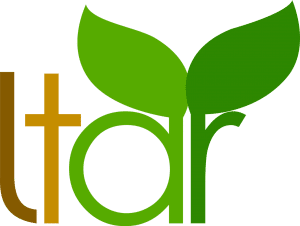Research
LTAR Network ResearchVision
Food for the future: Understanding and enhancing the sustainability of agriculture
Mission
A network developing national strategies for the sustainable intensification of agriculture production
The Sustainable Intensification of U.S. Agriculture
Agriculture in the United States must respond to escalating demands for productivity and efficiency, as well as pressures to improve its stewardship of natural resources. Growing global population and changing diets, combined with a greater societal awareness of agriculture’s role in delivering ecosystem services beyond food, feed, fiber, and energy production, require a comprehensive perspective on where and how U.S. agriculture can be intensified sustainably.
Agricultural intensification involves increasing production while optimizing the use of system resources. However, intensification also needs to be sustainable. This can be be done by balancing increased production with the need to conserve natural resources and to protect the environment while promoting rural prosperity.
Sustainable intensification will increase our food security while shrinking the environmental footprint of agriculture. These strategies strive to maximize yields while simultaneously reducing detrimental environmental impacts. However, they must also be tailored to distinct climatic, ecological, political, and socioeconomic contexts.

Productivity
Increase production per unit of input such as labor, time, land, water, fertilizer, agrochemicals, seed, or feed.
Rural Prosperity
Preserve cultural value, reduce reliability on external inputs, improve economic stability and resilience, and convey the social and environmental values of rangelands, grazinglands, and croplands.
Environment
Assess the synergies and tradeoffs among ecosystem services, such as greenhouse gas emissions, soil health, biodiversity, and water quality and quantity, to provide producers and agencies with important information and new techniques for management and economic decision making.
LTAR Coordinated Research
The LTAR network integrates question-driven research projects with common measurements on multiple agroecosystems (croplands, rangelands, and pasturelands) and develops new technologies to address agricultural challenges and opportunities. In addition, the LTAR network provides common measurements and data streams that complement other federally-funded national networks, such as the National Ecological Observatory Network (NEON) and the Long Term Ecological Research (LTER) network. The LTAR network features four linked approaches.
1. Coordinated Agroecosystem Research
Coordinating our research enables us to improve our understanding of how agroecosystems function at the field, regional, and national scales. Every network site has experiments with common goals and methods aiming to increase agricultural productivity and profitability while reducing negative environmental impacts, enhancing ecosystem services from agricultural landscapes, and improving opportunities for rural communities. Coordinated research allows scientists to develop and to test innovations across the United States, including new genetics, new production techniques, and sensor infrastructure.
2. Information Management

3. New Management Technologies and Tools
Producers, landowners, policymakers, and the public want to make informed decisions about agricultural systems based on productivity, ecosystem services, off-site impacts, market conditions, rural prosperity, and future climate. Linking field monitoring, remote sensing, computer models, and web and mobile technologies provides scientists and producers with the tools to evaluate the multiple effects of agronomic practices and to manage the tradeoffs between production and nonproduction services. Site-specific decision support tools can also enhance adaptive management, improve conservation investments, and reduce producer overhead costs.
4. Agricultural Innovation
Partnerships Effective engagement with producers, industry, and other stakeholders increases the utility and adoption of information and technologies. The LTAR network includes social scientists in collaborative experiments to understand stakeholder needs and to incorporate new science information in practices and technologies that are adopted by producers and accepted by the public. Collaborations with industry promote the refinement and dissemination of technologies and expand markets for sustainably-produced agricultural products.
LTAR Working Groups
Not all of the science needed for LTAR’s success exists. The LTAR network uses network-level working groups to achieve research goals. Working groups are research incubators that coalesce around specific topics and agricultural challenges and opportunities. The groups develop or improve research methods, models, and tools. These groups also carry out coordinated, large-scale data collection and provide the infrastructure required to analyze and to disseminate these data. Network-wide projects allow scientists from many disciplines to develop novel scientific insights at regional to national scales, evaluate whether and where these insights are applicable, and then adapt tools to local conditions. Working groups engage with stakeholders, producers, and industry in developing and disseminating these products.
| Group Type | Function |
|---|---|
| Measurement | Develop and implement methods to collect common measurements across thenetwork |
| Information Management | Provide the computing and data management infrastructure necessary for network-wide research |
| Coordinated Research | Conduct question-driven research ranging from regional to network-wide scales |
| Agricultural Management Technologies | Develop new tools to improve agricultural productivity and environmental outcomes |
| Outreach and Communication | Develop strategies to disseminate network developments and engage with producers, policy makers, and stakeholders |
Taking on the Big Challenges
Modern agriculture strives to provide food while maintaining other ecosystem services like clean air and water, biodiversity, and climate regulation. However, the increasing global population, greater demand for environmental stewardship, and changing climatic conditions require a concerted effort by all agricultural scientists to develop improved agricultural systems and strategies. The newly-formed LTAR network is uniquely poised to address the local to global challenges facing agriculture. For example, the LTAR network examines the influence of agricultural practices on the water cycle so that water resources can be used in the most effective and efficient manner. At the same time, the network develops new strategies for preserving and increasing soil health and for using nutrient resources wisely. Combining this knowledge allows LTAR scientists to develop innovative cropping systems and to improve grazinglands management while actively maintaining agroecosystem health.
Looking Towards the Future of U.S. Agriculture
The charge placed on the LTAR network is to anticipate and to prepare for the future of U.S. agriculture. The LTAR network was created to develop the science that renders agriculture sustainable and satisfies the needs of a growing global population without diminishing the provision or quality of other ecosystem services, while enhancing rural prosperity and the health, well-being, and prosperity of people for generations to come.
Increasing the production of commodities in the United States requires strategies that reflect the diversity of U.S. agroecosystems. However, as policies, markets, and consumers change demands on U.S. agriculture, agricultural science must rise to the challenge. To achieve greater productivity, agriculture must therefore adopt an approach that includes a genetics, environment, and management (Genetics x Environment x Management x Social interactions) approach to understand and to overcome the constraints to productivity, which is at the core of the LTAR network mission.

Efficient implementation of these strategies must target technology, management, and infrastructure to areas offering the greatest opportunities for greater productivity, new products and markets, and enhanced ecosystem services.
To support rural prosperity in the United States, agriculture must promote vibrant rural community institutions and economic infrastructures that provide equitable access to natural resources and reduce health risks to rural citizens. To accomplish this, LTAR also seeks partnerships with private industry that facilitate adoption of technologies and strategies where sustainable intensification of multiple ecosystem services is the shared goal.
The LTAR network looks forward to collaborating with other scientific institutions and networks (e.g., the U.S. Geological Survey, the National Oceanic and Atmospheric Administration, and the Natural Resources Censervation Service-Conservation Effects Assessment Project) to enhance interpretation of our findings. In addition, the LTAR network has and will continue to leverage additional funding from stakeholders and commodity groups to enhance research.
Ultimately, a balance of local and national concerns is expected to support effective strategies for sustainable intensification that reflect the broad diversity and national ambitions of the United States.
ABOUT LTAR
The USDA Agricultural Research Service (ARS) Long-Term Agroecosystem Research network consists of 18 Federal and university agricultural research sites with an average of over 50 years of history. The goal of this research network is to ensure sustained crop and livestock production and ecosystem services from agroecosystems, and to forecast and verify the effects of environmental trends, public policies, and emerging technologies.
